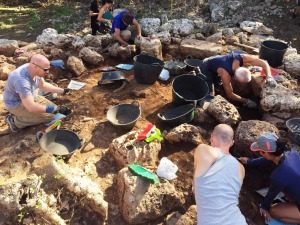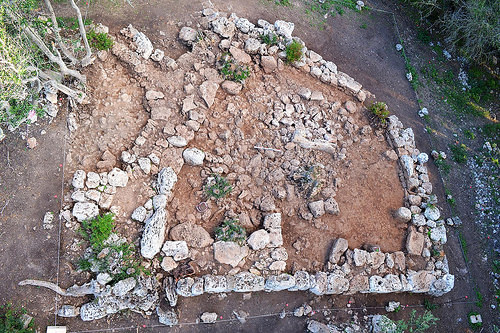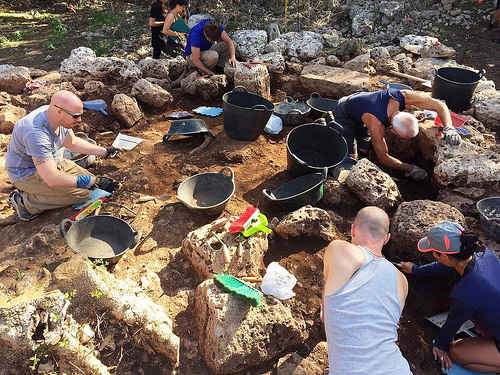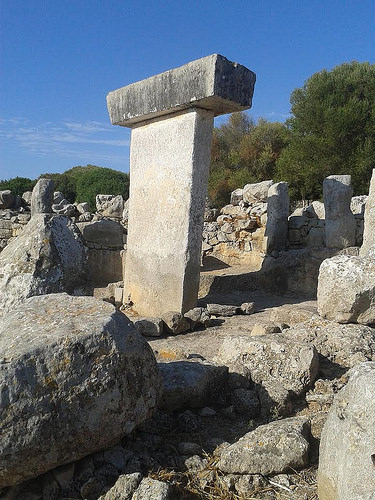
Archaeologists have recently begun revealing the features of an ancient prehistoric stone structure on the Mediterranean island of Menorca in the Balearic Islands, an archipelago near the eastern coast of Spain.
Beginning in 2015, under the direction of archaeologists Montserrat Anglada, Irene Riudavets, and Cristina Bravo, an archaeological team began excavating a newly opened structure at the site, known as Sa Cudia Cremada, a site that is composed of distinctive Iron Age (part of Spain’s prehistoric period) stone structures such as talayots — truncated tower-shaped constructions. The builders were members of the mysterious Talayotic culture, a people who left no written records, but whose architectural legacy dots the Balearic Islands.
“This research project started in 2015, when the team started digging remains of an Iron Age sanctuary, a site that was untouched until we first started digging in August,” said Bravo, one of the lead archaeologists. “The most important finding did not wait too long to be discovered and, during the first field school session one of the students found a large stone slab which was clearly broken and in situ. Its vertical position, its shape and location inside the building helped shed light on the building’s typology: it was a Taula monument.”
Characteristic of the Talayotic culture, the Taula is a large vertical monolith or supporting stone combined with a horizontal one resting on top, forming a large T-shaped monument. “Taula” means table in Catalan, as they were by tradition once thought to be tables used by giants. Now archaeologists suggest they were monuments representing Talayotic deities, occupying central positions in sanctuaries where rituals were performed.
“During archaeological excavations, new architectural elements were located, which are typical from these buildings, such as pilasters abutting the perimeter walls,” reports the archaeological team about the building in which the Taula is located. Also found were several grinding stones and pestles, as well as indigenous pottery, including artifacts from later periods, such as the Punic, Roman, Islamic, and Medieval periods.
_________________________________________
Aerial view of Sa Cudia Cremada’s taula sanctuary after the 1st excavation campaign. Courtesy Sa Cudia Cremada Field School
______________________________________________________
Fieldwork at Sa Cudia Cremada’s sanctuary. Courtesy Sa Cudia Cremada Filed School
______________________________________________________
One of the taula sanctuaries already excavated in Menorca: the Taula sanctuary at Torralba d’en Salort. Courtesy Sa Cudia Cremada Field School
_______________________________________________________
The Talayotic culture is a society that flourished on the Gymnesian Islands (the easternmost Balearic Islands) during the Iron Age. Its origins date from the end of the second millennium BC. It is named after the talayots, abundant and emblematic structures from the prehistoric period of the Balearic Islands. Archaeologists are continuing to piece together excavated clues that are still raising more questions than answers, but progress is slowly being made. “Archaeological excavations and research tasks are slow and laborious,” reports the team. “As a consequence, the team has a long way to go to be able to ascertain all these questions and others, which will shed light on the function and significance of this type of unique sanctuary from Mediterranean Prehistory.”
An in-depth feature article about the new excavations at Sa Cudia Cremada will be published in the upcoming Summer 2016 issue of Popular Archaeology Magazine.
Individuals wishing to know more or who may be interested in participating in the excavations may visit the project’s website: http://archaeologysacudia.com/en/ or contact the team at [email protected].
_________________________________________

______________________________________________
Travel and learn with Far Horizons.
____________________________________________
This richly illustrated issue includes the following stories: Recent findings shedding new light on the whereabouts of the remains of Philip of Macedon, father of Alexander the Great; how an archaeologist-sculptor is bringing bones of the dead back to life; archaeologists uncovering town life at the dawn of civilization; an exclusive interview with internationally acclaimed archaeologist James M. Adovasio about what makes the Meadowcroft Rockshelter prominent in the ongoing search for the first Americans; what archaeologists are finding at the site of the ancient city of Gath, the home town of the biblical Philistine giant, Goliath; and how scientists are redrawing the picture of human evolution in Europe. Find it on Amazon.com.









